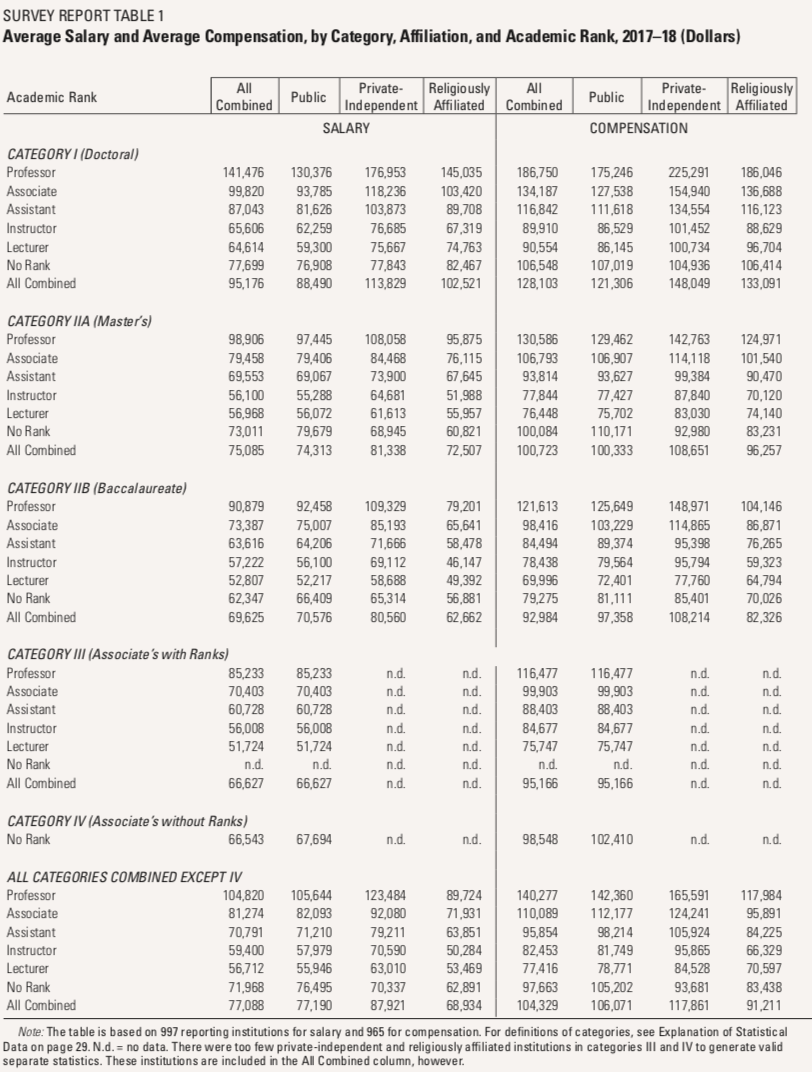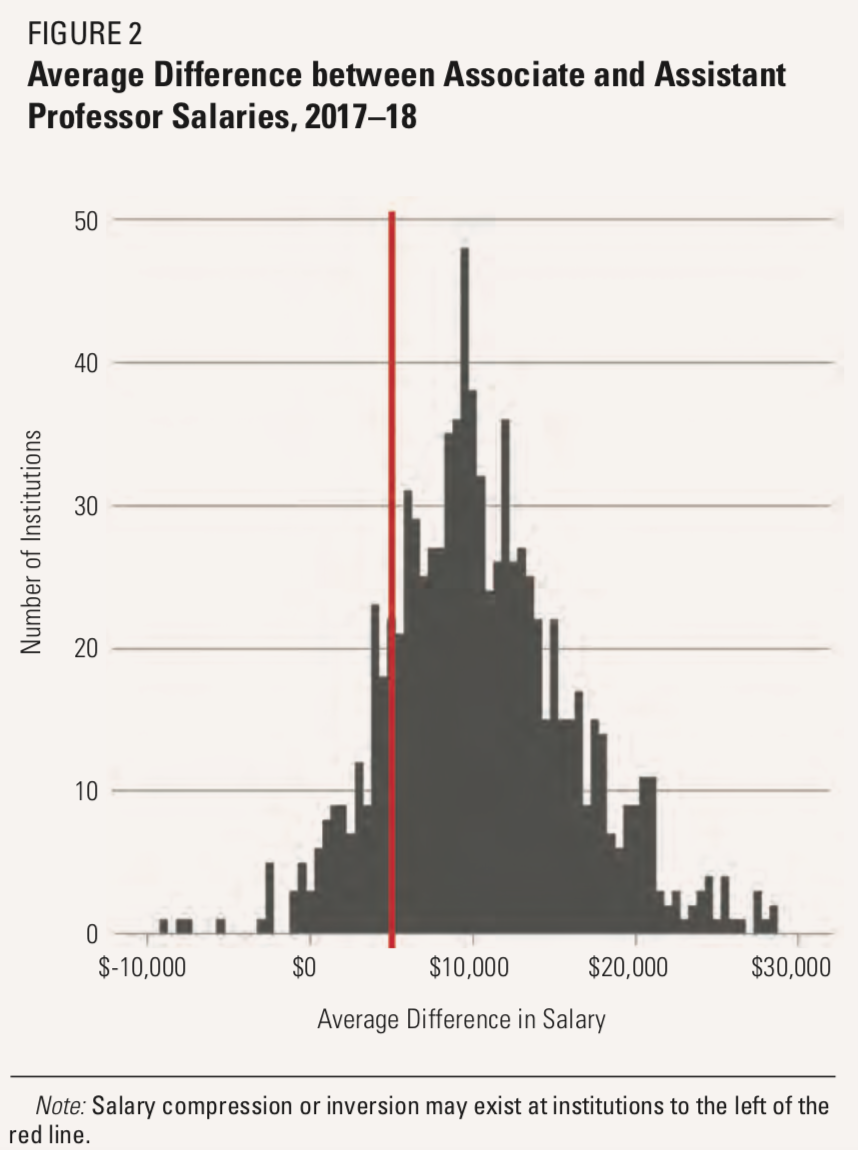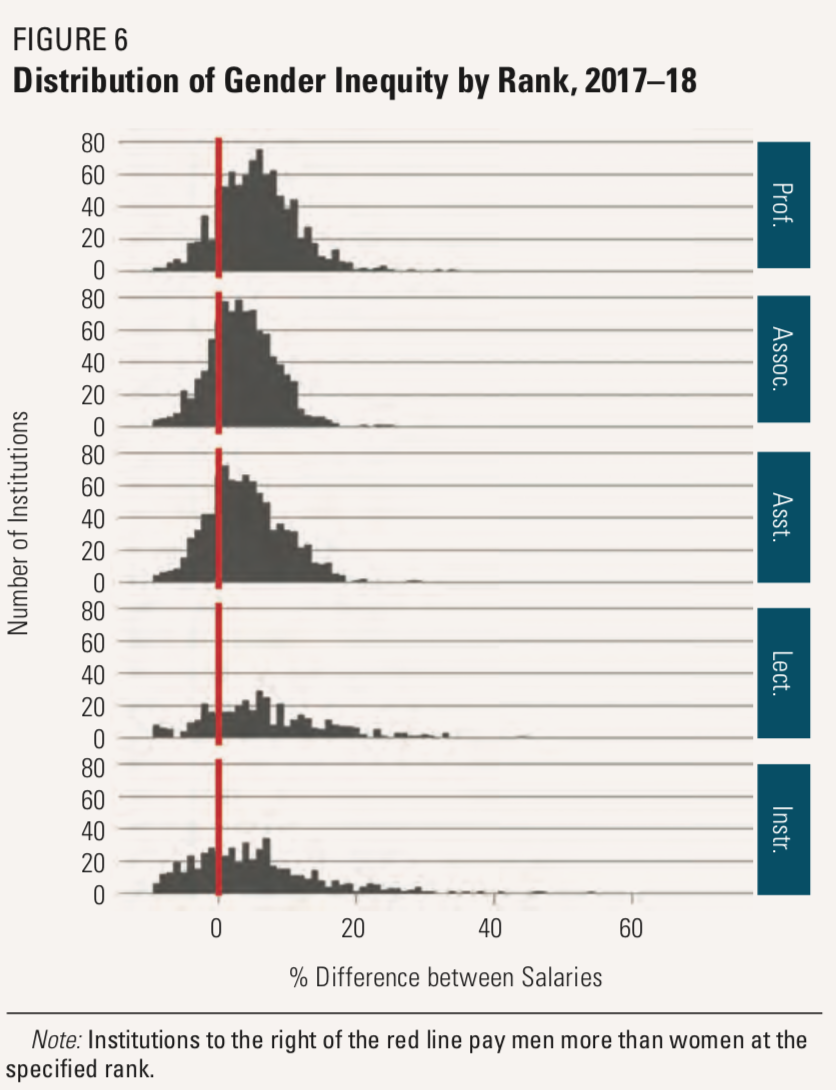You have /5 articles left.
Sign up for a free account or log in.

Getty Images
Average salaries for full-time continuing faculty members increased by 3 percent this year over last, according to the American Association of University Professors’ Annual Report on the Economic Status of the Profession: 2017-18.
Database of Faculty Pay
Inside Higher Ed is the exclusive home
of the AAUP's survey on faculty
compensation. Click here to browse
the data for your institution -- or
the place you'd like to work.
That amounts to about 1 percent, adjusting for inflation, the association notes with a cheeky reference point: presidents of institutions that participate in the AAUP’s annual study make 4.78 times more, on average, than their full-time professors.
More than 1,000 institutions representing 378,865 full-time faculty members responded to the AAUP’s Faculty Compensation Survey, from which the new report is derived. The average full professor salary this year was $104,820. Associate professors earned $81,274 in salary, on average, and assistant professors were paid $70,791. Lecturers earned $56,712, on average and instructors earned $59,400.
Each year, AAUP’s analysis touches on different aspects of faculty pay. The new report discusses salary compression, or w hen professors at lower ranks are paid close to what higher-ranked professors are paid due to market and other differences at their points of hire. It’s a difficult thing to fix, especially at public institutions with fixed salary options, but it’s a major morale killer that contributes to faculty turnover.
hen professors at lower ranks are paid close to what higher-ranked professors are paid due to market and other differences at their points of hire. It’s a difficult thing to fix, especially at public institutions with fixed salary options, but it’s a major morale killer that contributes to faculty turnover.
Among those 892 participating institutions with 10 or more faculty members at the assistant and associate professor ranks, the average difference between associate and assistant professor salaries is $10,600. The red line in Figure 2 (below) represents a difference in pay between ranks of $5,000, to the left of which compression may exist. About 100 institutions are to the left of the line but above a zero-dollar difference, while 22 additional institutions actually pay their assistant professors more than their associates, on average, meaning not salary compression but actual salary inversion exists.
AAUP’s report this year also attempts to frame salary and compensation data within larger national conversations abo ut retirement benefits, declining state funding for higher education and early-career faculty members.
ut retirement benefits, declining state funding for higher education and early-career faculty members.
Benefits and Declining Public Support for Higher Ed
“Drastic cuts in state appropriations have often affected faculty at public colleges and universities more than other public employees as legislators have targeted higher education budgets,” the report says.
“And states with catastrophic decreases in support for higher education have typically faced a corresponding financial crisis caused by the underfunding of public pensions. The coming retirement crisis for employees under 40 is worsened for early-career faculty because of their late entry into the work force relative to other employees.”
As for benefits, the AAUP says that “broader societal trends affecting retirement and health benefits hit faculty especially hard.” What appear to be “very generous retirement benefits for some faculty become much less generous when the mobility required for early-career faculty is considered,” reads the report.
Among institutions in the 25th to 75th percentile in AAUP’s survey, the average total benefits for full-time faculty members are between 18 and 31 percent of their annual salaries.
The average retirement contribution for full-time faculty members ranges from 7.7 percent to 11.8 percent among institutions in the 25th to 75th percentile.
While some public institutions seem to offer better retirement benefits than private institutions, some are not paying into Social Security for their employees, the report notes. And increasing health-care costs also have affected the faculty, according to AAUP, as participating institutions’ employer contributions to health-care plans were below the 3 percent national average increase in premiums.
Year over year, there was an average increase of $207 in medical benefits paid per faculty member. The average medical contribution for full-time professors was between $5,156 and $10,455 at institutions in the middle 50 percent.

As for tuition benefits, usage seems to be near 10 percent at most institutions, and higher (about 15 percent) at public two-year institutions. Public institutions, meanwhile, are less likely than the pool over all to offer tuition benefits as part of their packages: less than one-third of public institutions report a tuition benefit greater than zero, compared to seven of 10 private institutions.
The AAUP says data from its report can be used to help faculty members work toward greater pay equity for part-time faculty members, increased state funding for higher education, and other improvements -- such as salary equity between men and women.
Pay by Gender and Part-Time Status
To that last point, AAUP data this year show that 93 percent of all participating institutions pay men more than women at the same rank.
 In a separate write-up on gender, rank and faculty pay shared this week on the association’s “Academe” blog, AAUP research assistant Chelsea Fowler said that while women “have made strides in achieving parity with men in ranked positions,” they continue to face barriers breaking into the highest -- and highest-paid -- rank of full professor.
In a separate write-up on gender, rank and faculty pay shared this week on the association’s “Academe” blog, AAUP research assistant Chelsea Fowler said that while women “have made strides in achieving parity with men in ranked positions,” they continue to face barriers breaking into the highest -- and highest-paid -- rank of full professor.
Fowler attributes this “leaky pipe” to the top in part to inadequate institutional support, sexual harassment and institutional reliance on part-time positions -- and the female instructors who remain concentrated in these ranks with few opportunities for advancement -- along with unconscious bias, lack of mentorship and problems achieving work-life balance.
The AAUP report says that its survey instrument doesn’t collect information on length of service or discipline, but that “available data clearly show that more work is needed to end the pay gap in higher education. No change in gender inequity is visible as faculty advance through the professorial ranks, indicating that equity is not likely to be achieved in the near future. Many institutions also have large gender pay gaps at the lecturer and instructor ranks.”
AAUP’s survey historically has been criticized for focusing primarily on full-time professors. This year it offers some insight into an understudied aspect of part-time employment: benefits. Just 5 percent of institutions reported offer part-time faculty members a full benefits package, while another 33 percent of institutions reported offering part-timers some benefits.
Joseph Roy, a senior researcher at AAUP, said this week that part-time faculty salary data remain underreported by participating institutions -- at just about 20 percent. That’s in part because they often don’t have the data in a central location, he said, due to the decentralized manner in which adjuncts are typically hired.
Moreover, participation in AAUP’s annual survey is voluntary, Roy said, and institutions may not want to share information that could put them in a “poor light” -- namely the relatively low pay that adjuncts often get, especially as compared to their full-time colleagues.
Below are some data on what reporting institutions pay part-timers who teach on a per-course basis, but they don't include how many courses those professors are teaching. The data therefore lack context -- and meaning.
Roy said he nevertheless planned to discuss the issue with participating institutions going forward and possibly adjust the survey instrument to promote reporting. One possibility is asking for year-old -- not current -- pay data for adjuncts, which presumably would be easier to access.

As for AAUP’s attention to gender and pay this year, Roy said he and colleagues have of course been paying attention to broader cultural conversations.
While AAUP can’t “directly address the issues around harassment empirically with the survey data,” he said, “we felt that we could provide some evidence for a discussion” beyond what’s typically available in the report.
Who Earns Most, Where
Inside Higher Ed is the sole holder of AAUP’s full compensation database, available here. Beyond the important issues highlighted by the association in its report, readers each year are curious to know which institutions pay their professors the most. Region matters -- the data consistently show that professors in the Northeast, Mid-Atlantic and West Coast earn more than their colleagues elsewhere. But institutions matter, too, of course.
The top 10 full professor salary list, by institution, is similar to last year’s. Harvard University displaced Princeton University at No. 3, however, from No. 5. Northwestern University also made the list at No. 10, kicking off Duke University.
Top Salaries for Full Professors at Private Universities, 2017-18 (Average)
|
1. |
Columbia University |
$251,300 |
|
2. |
Stanford University |
$246,200 |
|
3. |
Harvard University |
$245,800 |
|
4. |
Princeton University |
$238,000 |
|
5. |
University of Chicago |
$234,300 |
|
6. |
Massachusetts Institute of Technology |
$222,800 |
|
7. |
University of Pennsylvania |
$217,300 |
|
8. |
New York University |
$214,500 |
|
9. |
Yale University |
$214,300 |
|
10. |
Northwestern University |
$211,200 |
The University of California System claimed five of the top 10 public institution spots for full professor salaries again this year, with the Los Angeles campus remaining No. 1. The Georgia Institute of Technology entered this list in 2017-18 at No. 3, displacing Rutgers University at Newark, which fell to No. 4. Rutgers’s New Brunswick campus fell off the list from No. 10 last year, making room for Georgia Institute of Technology. The University of Maryland also left the top 10 list this year, dropping from No. 8 last year.
Top Salaries for Full Professors at Public Universities, 2017-18 (Average)
|
1. |
University of California, Los Angeles |
$204,000 |
|
2. |
University of California, Berkeley |
$191,200 |
|
3. |
New Jersey Institute of Technology |
$187,700 |
|
4. |
Rutgers University at Newark |
$183,100 |
|
5. |
University of Virginia |
$177,300 |
|
6. |
University of California, Santa Barbara |
$176,100 |
|
7. |
University of California, Irvine |
$171,300 |
|
8. |
University of California, San Diego |
$171,200 |
|
9. |
University of Michigan at Ann Arbor |
$170,200 |
|
10. |
Georgia Institute of Technology |
$168,400 |
Liberal arts colleges paying the top salaries for full professor look nearly the same as they did last year. The most significant change on the top 10 list by institution was Amherst and Swarthmore Colleges swapping spots, to fifth and seventh, respectively.
Top Salaries for Full Professors at Liberal Arts Colleges, 2017-18 (Average)
|
1. |
Barnard College |
$168,700 |
|
2. |
Claremont McKenna College |
$166,800 |
|
3. |
Pomona College |
$156,500 |
|
4. |
Wellesley College |
$156,100 |
|
5. |
Swarthmore College |
$153,100 |
|
6. |
Wesleyan University |
$152,600 |
|
7. |
Amherst College |
$151,000 |
|
8. |
Harvey Mudd College |
$148,100 |
|
9. |
Colgate University |
$147,000 |
|
10. |
Williams College |
$146,900 |
Among top salaries for assistant professors, Harvard jumped to No. 1 this year, from No. 5 last year. Babson College dropped one spot, to No. 2. California Institute of Technology also fell down the list, from No. 3 to No. 5 year over year. Bryant University entered the list this year at No. 10, displacing Northwestern.
Top 10 Colleges With Six-Figure Salaries for Assistant Professors, 2017-18 (Average)
|
1. |
Harvard University |
$140,700 |
|
2. |
Babson College |
$134,500 |
|
3. |
Stanford University |
$131,600 |
|
4. |
University of Pennsylvania |
$130,300 |
|
5. |
California Institute of Technology |
$128,300 |
|
6. |
Columbia University |
$126,200 |
|
7. |
Massachusetts Institute of Technology |
$124,500 |
|
8. |
University of Chicago |
$121,400 |
|
9. |
Bentley University |
$118,600 |
|
10. |
Bryant University |
$117,300 |









